Today, in the Books We Love Insider Blog I write about my new activity for the pandemic – e-biking.
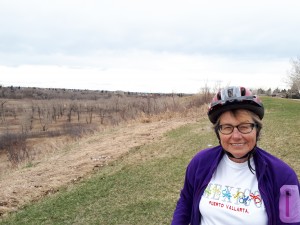
Today, in the Books We Love Insider Blog I write about my new activity for the pandemic – e-biking.

Today I wrap up my five-part blog series about my drive across Canada during the pandemic.

![1301_NE_Broadway_-_Irvington_HD_-_Portland_Oregon[1]](http://susancalder.com/wp-content/uploads/2020/04/1301_NE_Broadway_-_Irvington_HD_-_Portland_Oregon1-300x225.jpg)
![o[1]](http://susancalder.com/wp-content/uploads/2020/04/o11-300x225.jpg)

Our next highlight was a scavenger hunt through Medicine Hat, Alberta, to find a Subway restaurant for our takeout lunch. We plugged the first one into our GPS, which directed us to a suburban shopping mall. The restaurant was closed. The next closest one was across the highway. It was open, but the clerk said the restrooms weren’t working.
We continued our quest to Subway # 3, downtown. The GPS announced that we’d arrived, but we couldn’t see a Subway sign. We followed the riverside, past a splendid train station in the historic downtown, and crossed the bridge to the next Subway. Closed. We plugged in Subway #5.
![train station medicine hat history cpr (8)[1]](http://susancalder.com/wp-content/uploads/2020/04/train-station-medicine-hat-history-cpr-811-300x172.png)
Its neon ‘open’ sign glowed. We pushed restaurant door open. Eureka!
“Can we use your washroom before ordering?” we asked.
“Go ahead.”
Armed with our foot-long tuna sandwich, we left the town and decided our best bet for a scenic car picnic lunch was a range road. We turned off at the first reasonable one and parked at a wide point in the road with a distant view of Medicine Hat. As we took out our sandwiches, a pickup truck rumbled behind us and stopped.
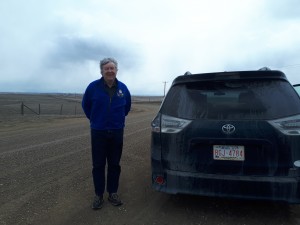
“Do you need help?” the driver asked.
“We’re just here eating lunch.”
“Okay.” He smiled and drove onto the highway.
After lunch, we were into the homestretch of our five-day journey across Canada. One more stop in Bassano for gas, restrooms and a non-memorable snack from the convenience store. Approaching Calgary, we saw the skyline. Soon we were cruising the Deerfoot Trail, in no-longer-rush hour traffic. Minutes later, we turned into our neighbourhood and drove by our fitness centre, its parking lot empty. To our right was our library., closed; our mall, closed except for Shoppers Drug Mart; our Safeway grocery store, thriving, but changed inside by the new social distancing protocols.
Now I’ve been home for five days and find the restrictions easier to handle in my own place. Will and I feel less isolated here in our familiar surroundings and with opportunities to meet neighbours on the street, from a safe distance. We can each do a variety of activities around the house and yard, as well as clean up the crumbs in our car from the picnic lunches. In Ottawa, we didn’t have our bicycles. Yesterday, in beautiful spring weather, we rode around Calgary’s Glenmore trail and I’ve rarely seen it as crowded. All of sudden, everyone has discovered walking. Who knew it existed and could be fun?
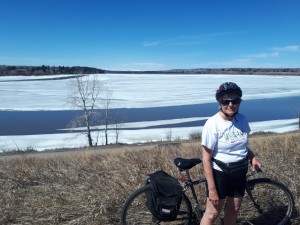
![Shout-sister[1]](http://susancalder.com/wp-content/uploads/2020/04/Shout-sister11-300x199.jpg)
My friend got into choir for something to do after she retired. Before then, she’d had no interest in singing and, unlike me, hadn’t taken piano lessons as a kid. She explained that some choirs required auditions. Others don’t, including Shout Sister, her all-female choir.
She gave me printouts of lyrics to her group’s current roster of songs. Leonard Cohen., Simon & Garfunkel, The Beatles; my long-time favourites. I had spare time and was looking for activities this winter, since I was away from home in Ottawa, helping a relative through medical treatment.
“I’ve arranged for you to try out the choir this week,” my friend said. She’d also convinced the administrator to give me a special rate if I decided to stay, since I’d only be there for part of the year.
“Okay,” I said, because she’d gone to all this trouble.
Wednesday afternoon, we drove to her choir practice at a local church. About seventy women, mostly seniors like us, stood in a horseshoe shape facing the choir leader. No sheet music. The notes rose and fell with the leader’s hand, a method of music reading I found easy to follow.
The meeting brought back memories of my youthful choirs. “Don’t interrupt the line of music by taking a breath.” The director echoed my earlier choir leaders. “Sustain the last note.” The large group sang harmonies that sounded lovely to me. I found myself able to sing all the notes. Either the organizer selected songs suited to amateurs or she arranged them for unpracticed female voices.
Best of all, for those two hours of song I forgot my worries about my family member’s health challenges. The choir had me hooked.
I looked forward to the weekly sessions. After two months, a woman I talked to during the break convinced me to participate in the next week’s concert at a retirement home. Performing with the group was fun and gave a new dimension to choir practice. Our concert ended with the 1970s O’Jay’s anthem, Love Train, which urges people around the world to join hands and form a train of love. At the rousing finish, we were supposed to join hands with the person beside us. Some of us did; others refrained.
The following week our choir session was cancelled due to COVID-19. It soon became clear we wouldn’t be singing for weeks and months. Then the organizers set up practices on Zoom, a virtual meeting site that has taken off in this time of home isolation.
I’m not swift with technology and worried I wouldn’t figure out Zoom, but with a little advice, Zoom worked easily and well. Now, I follow the leader on my computer screen, while thumbnail pictures of choir members appear along the top or side. During breaks, I switch to gallery view, with thumbnails filling the screen. The first two weeks, over fifty members signed in each time. I’ll miss week three since I’ll be driving from Ottawa, west across Canada to my home in Calgary .
At the virtual Zoom session, the director puts us all on mute, since the system can’t co-ordinate our voices. I discovered my voice doesn’t sound as good alone as I sounded to myself with the group. It still cracks and strains for those high notes.
I wouldn’t want to start with choir online, but virtually continuing with familiar faces and songs was more satisfying than I’d expected. Again, for those two hours, choir brought me out my despondent mood. For the first time since this mass isolation began, I felt that most of us won’t be permanently damaged and we’ll return to our humankind.
Shout Sister operates in numerous Ontario locations. Ottawa has three branches, with our afternoon group the most recent sister. Here’s a YouTube video of one of our older sister groups performing Ben E. King’s Stand By Me, a song our newer group learned this year.
Shout Sister Ottawa \’Stand By Me\’

I have several friends in Calgary who belong to choirs. A year ago, I asked one of them what he gained from being in a choir. He said, “When you sing together, you make each other so much more.” I agree.
On day # 4 of our drive from Ottawa to Calgary, we set out from Winnipeg in sunshine. By now we had our routine down pat. Stop at Tim Hortons mid-morning and/or mid-afternoon for a coffee/tea/hot chocolate/donut and restroom break. Stop at some point for gas and restrooms. The plan never worked exactly right. Some of the gas stations closed their restrooms to customers and we had to find an alternate place. In the outskirts of Regina, usually reliable Tim Hortons was only open for drive-through customers. We went next door to the Esso convenience store, where Will bought a litre of chocolate milk as compensation.

Our lunch routine involved buying a sandwich at Subway, after using their restroom. We usually ordered the 12 ‘ daily special to share, topped with veggies, with pickles on my half, and then looked for a scenic place for our picnic in the car. Today, we drove into Wapella and parked facing the small town’s Centennial Park, which was open to wander through. While it was still too cold to eat at the picnic table, the temperature rose on our way to our 4th night’s destination, Moose Jaw. For the first time on this trip, it was warm enough for a comfortable walk outside. Our Moose Jaw hotel backed onto an unfenced golf course. Will asked the reception desk clerk if we were allowed to walk on it.
“I guess so,” she said. “Why not?”
“Sometimes there are rules about being in public parks.”
“Hmprh,” she said. “I hope all this ends in a few weeks.”
Don’t count on it, we thought.
The next morning, a different reception desk clerk told us she was really glad to see some travellers.
“It’s essential travel,” I said, not wanting her to think I was doing this for fun.
From my limited experience of small town Manitoba and Saskatchewan, provinces with relatively low COVID rates, I think they’re generally following the protocols, but the peoples’ hearts aren’t in it, since they don’t feel personally threatened yet. Will thought the hotel and restaurant clerks in suburban Winnipeg were more relaxed about the rules than their counterparts in Ontario. Our Winnipeg hotel clerk grazed his hand as she passed him our room keys.
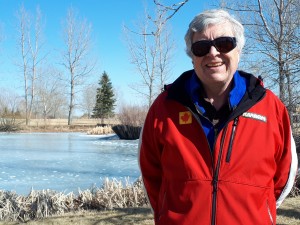
After our pleasant walk on the Moose Jaw golf course, it was time to order dinner. Once again, our first choices of restaurant either didn’t answer the phone or their websites said they were temporarily closed due to COVID. Then, I remembered seeing a Humpty’s restaurant across the main street into town. It turned out to be open for takeout. Will and I easily jay-walked across the street, which would normally be busy at the end of a work day. To honour the rule of minimizing people in restaurants, Will went inside to get our order while I waited in the sunny, empty parking lot.
This was one of many moments, since #stayhome began, that I’ve felt like a nuclear holocaust survivor, who emerges from her underground shelter to find her city’s buildings, streets and playgrounds largely intact, but its people and activity strangely absent.
At the midpoint of our drive across Canada, Will and I tackled the Dryden moose and the Manitoba border patrol
![Dryden, Ontario, day 2 008[1]](http://susancalder.com/wp-content/uploads/2020/04/Dryden-Ontario-day-2-00812-300x225.jpg)
On day # 3 of our drive from Ottawa to Calgary, Will and I left Thunder Bay in snowfall. Traffic was light this Easter Monday morning, but we drove slowly on the slush-covered highway. The Great Lakes behind us, we were into what I’d call the least scenic section of our trip. Stunted trees interspersed with occasional railway towns. We wondered what we’d encounter at the Manitoba border, having read that the province had set up border patrols on the incoming highways as part of their effort to combat COVID-19. Manitoba has the lowest number of coronavirus cases of any province west of New Brunswick and wants to keep it that way.
![Dryden, Ontario, day 2 008[1]](http://susancalder.com/wp-content/uploads/2020/04/Dryden-Ontario-day-2-00811-300x225.jpg)
The snow stopped by lunch time and rays of sunshine emerged. We bought Subway sandwiches in the town of Dryden and parked beside the Moose statue for our car picnic lunch. Today’s drop in temperature to below freezing, with brisk wind, made the picnic table by the moose not the least bit tempting.
The scenery perked up around Lake of the Woods. We stopped in Kenora for gas and restrooms in the station’s convenience store. When we found the restrooms closed, the store clerk directed us to a local Tim Hortons restaurant. Somehow we missed it and found ourselves on the highway out of town. Fortunately, Will remembered a Tourism Ontario restroom a short distance ahead. It was open, with signs above the sinks telling us not to drink the rust-coloured water.
Refreshed, we approached the Manitoba border with our story prepared.
‘Yes, we know the government told everyone to go home weeks ago, but we had to stay in Ottawa to help our son through his medical treatment. We aren’t travelling for fun, we’re going home; look at our Alberta license plate.’
Entering border control was similar to entering a construction zone. Neon signs, pilons narrowing the road and a woman holding a sign instructed us to slow down. We stopped by a man, who held a long pole out to our car window with a sheet of paper attached to the end.
“This might contain information that applies to you,” he said.
Will grabbed the paper. “No questions?”
“Nope.” The man smiled and waved us on.
I liked the friendly way they handled this. The paper’s one page message advised international and domestic travellers to Manitoba to self-isolate for 14 days, along with the usual COVID-19 instructions for social distancing and handwashing.

Soon we were in flat prairie, and two lane divided highway that would continue all the way to Calgary. Now in the middle of our trip, we passed Lorette, Manitoba, the longitudinal centre of Canada, as determined by a measurement of the distance from Canada’s farthest outlying islands on the east and west coasts.
The rivers in Winnipeg looked high to us, judging by the trees standing in the water rising up the banks. When we checked into our hotel, the reception clerk said that most hotels in the city were closed and we wouldn’t be bothered by people in our hotel because no one was here. An exaggeration, since a half dozen cars were parked in our courtyard that night. But with all of our hotels about 1/4 occupied and no one in the common areas, we were barely aware of others staying in our accommodations.
No answers from the first two restaurants we called to order our takeout dinner. With lucky call # 3 we chose a large grilled salmon meal to share.
Over dinner, Will said that his biggest memory of this trip so far was seeing almost everything closed. But there’s always an upside. Low traffic made the driving comfortable and easy. The empty restaurants and near-empty hotels were grateful for our business. Our hotel rooms were quiet, with no noise from neighbours and the street. It felt like whatever services were open and the whole infrastructure were there just for us and the other isolated travellers unable to #stayhome.

Today is the second installment of my blog post about my five day drive last week from Ottawa to Calgary. I’ve done this route four times before. COVID-19 made it different.


Easter morning, my husband Will and I picked up our breakfast at the motel reception desk. The generous bags included oranges, bagels and muffins, and granola bars that we set aside for later. A package of Easter eggs added a tasty dessert.
We hit the road for day #2 of our drive from Ottawa to Calgary. This is the fourth time we’ve done this trip and we consider this stretch from Sault Ste. Marie to Thunder Bay the most potentially treacherous. The two lane highway winds, rises and falls around Lake Superior. Weather can be harsh and unpredictable. On our eastbound trip in November, we ran into a snowstorm, which made the driving scary for two hours. It didn’t help to see trucks flipped over beside the road. On this return trip, we met fewer trucks than usual and didn’t see any overturned.
Today, the road was clear, the sky a mix of sun and cloud that enhanced the changing views. Lake Superior was still partly frozen. Chunks of snow perched on rocks that jutted from the water. I saw paintings in every direction. Plaques along the road call this section The Group of Seven Highway.

Will and I have two must-stops on the route. The first is the Winnie-the-Pooh park in the railway town of White River. Displays tell how an army captain, en route to Europe in 1914, bought a bear cub from a local hunter and named the cub Winnie after his home city, Winnipeg. He brought the bear with him overseas to England. When he left to fight in France, he donated the cub to the London Zoo. Winnie became popular with zoo visitors, including author A. A. Milne’s son, Christopher Robin, who named his teddy bear after Winnie. This rest is Winnie-the-Pooh history. It’s safe to say that none of this story could happen in today’s more protective age.
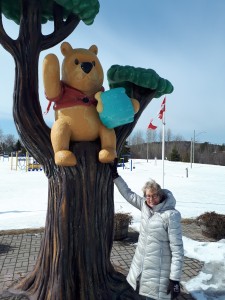
Will and I would have eaten our lunch in Winnie’s park, if it wasn’t cold and the picnic tables weren’t snow covered. Instead, we drove into the resort town of Marathon for a car picnic at the beach. We discovered the playground and beach were closed due to COVID-19, but we could still park for a glimpse of the water.
Our second must-stop is the Terry Fox Memorial in Thunder Bay. The monument is located a few miles past the spot where Terry Fox was forced to give up his run across Canada when his cancer returned and spread. He died less than a year later. His memorial is set on a hill with a superb view of Lake Superior. The site is free to visit and a short stop on a long drive. I’d only skip it if I were in a rush, or caught in driving rain or snow, or if it was closed for a pandemic. As Will and I approached the turnoff, we expected to find a barrier at the road entrance, like we’d seen at most of the tourist sites and rest areas we’d passed earlier in the day.
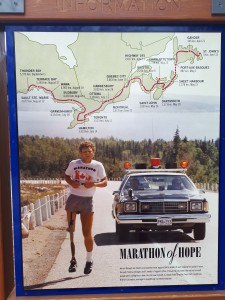
To our surprise, the road curving up the hill was open. The visitor’s centre was closed, of course, but several small groups of people gathered around the monument, respectfully keeping their distance from each other. When Will and I studied the display map of Terry’s Marathon of Hope, we realized that today, April 12, 2020, was the fortieth anniversary of the start of Terry’s run. On April 12, 1980, in St. John’s, NFLD, he dipped his foot in the Atlantic Ocean and began his journey west. It ended Sept 1.

I’m especially glad the monument was open during this pandemic because we need Terry’s message of hope. Let’s hope that by Sept 1, 2020, larger groups will be able to gather at the memorial to celebrate Terry Fox’s courage and inspiration.
On Easter weekend, my husband Will and I set out from Ottawa to drive home to Calgary. We’d spent the winter in Ottawa helping our son Dan through chemotherapy and delayed our trip as long as we comfortably could. Our stay was prolonged by our other son Matt’s return to Ottawa from Mexico. Matt needed us to bring him groceries during his two week isolation. Will and I handled the grocery shopping for three households, Dan’s, Matt’s and our own in a rented apartment. When Matt was released, he joined us in the apartment for a few days together. Thursday, we all enjoyed a farewell turkey dinner at Dan’s house. On Good Friday, Will, Matt and I walked to the trendy Glebe neighbourhood of Ottawa to buy our favourite bagels. In the afternoon, we packed the car and played Canasta (Matt won). Saturday. Will and I hit the road, leaving Matt behind in the apartment to be with Dan for his last treatment.
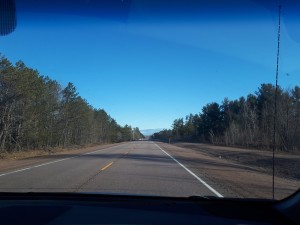
Traffic on the highway was light, as it had been in Ottawa since the COVID-19 restrictions began and people started working from home. I realized this was one of my few trips to the countryside since we’d arrived in Ottawa on Nov 5, 2019. Our last country excursion was to a maple sugar shack in the Gatineau. We went in early March, the first week of the sugar season, and were glad we did it while we could. This was one of our many ‘glad we went before it closed’ conversations during our last weeks in Ottawa.
Activity on the road picked up at our first stop, Petawawa, with people out for their Easter shopping. We passed a lineup outside the local grocery store, stopped at Tim Hortons for our morning break and were thrilled to find they’d kept one washroom open for customers. The other two were barred off for COVID. At the counter, the clerk said, of course they accepted cash for payment. The stores I’d been to in Ottawa lately had only taken debit or credit cars. I opened my wallet in Tims. My fingers stumbled on the clasp as I momentarily forgot how to pay with cash. When I handed the clerk my toonie, our hands touched, another odd experience these days. While the countryside has geared up for COVID-19, residents might feel less threatened than they do in the bigger cities with their larger illness counts.
After our next stop for gas and a washroom break, we looked for a spot to eat lunch. We’d made turkey sandwiches from our leftover meal and brought snacks to use on the trip. Sudbury’s ring road winds along an escarpment beside the city. We stopped at a lookout and ate in the car, since it was around zero degrees and windy outside. We both reflected on our first trips to Sudbury, in the 70s, when the devastation from the mining activity had reminded me of the surface of the moon. Now, trees make the city liveable.


From Sudbury, we drove to our first night’s lodging in Sault Ste Marie. Sunshine made the landscape along the way pretty. Waterways, rivers and lakes, still partly covered in ice. We’d reserved a motel near the waterfront. Only a couple of cars were there when we arrived. We planned to stay at the Choice hotel chain at each stop on our trip and learned their current policy is to not touch rooms for several days after guests leave, during the time any COVID germs might linger on surfaces. They also don’t clean rooms each day for multiple stays and, instead of their usual hot buffet breakfast, provide a bag of cold breakfast food.
Since we’d arrived early and it was ten degrees and sunny, albeit windy, we walked along the waterfront park, looking for the bust of Roberta Bondar, Canada’s first female astronaut, which we’d seen on our cross country drive many years ago. After posing with Roberta, we picked up a takeout dinner of ribs from Montana’s and brought it back to our room to eat, watching ships cruise down the river between Canada and the US, our mutual border now closed.
Another glad – to have day one, with our longest driving time, under our belts. Four days to go. I’ll report on day two tomorrow.